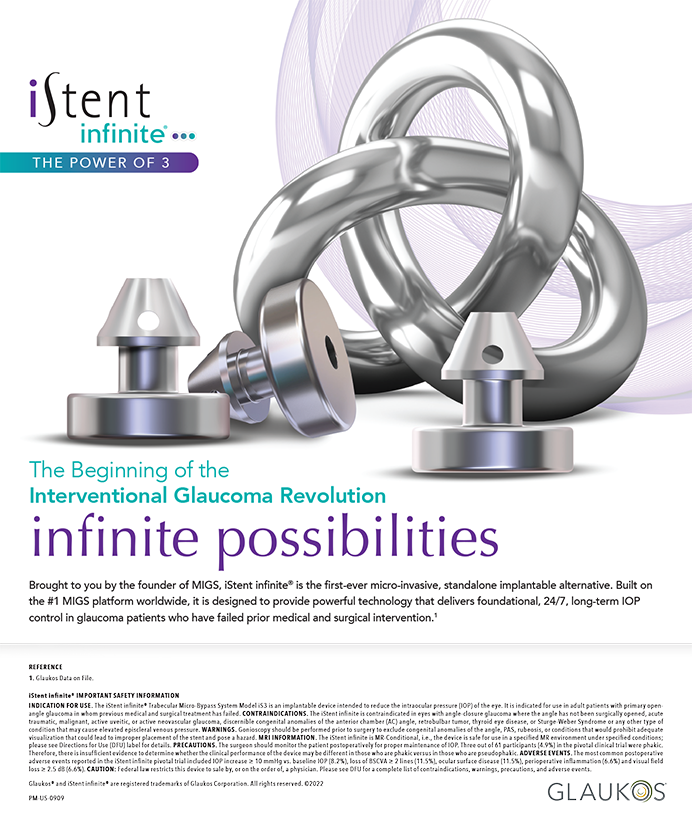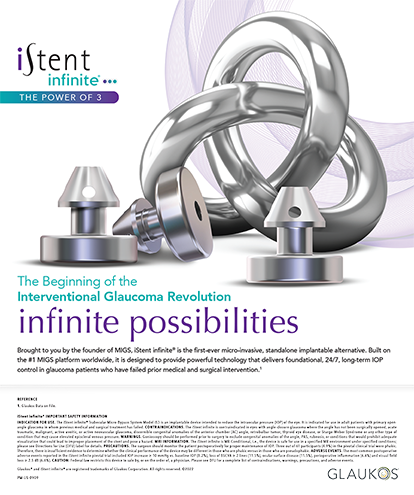The popularity of optical coherence tomography (OCT) as a tool for comprehensive imaging of the anterior segment has grown steadily, owing to its fast scanning speed, high resolution, and increasing number of applications for disease management and surgical planning. In its current iteration, this noncontact imaging technology relies on Fourier transformation of the power spectra to recover information on tissue reflectivity and produces high-resolution, cross-sectional images in vivo.1
OCT was introduced in 1991 for studying the posterior segment.2 Anterior segment imaging was first demonstrated with time-domain OCT in 1994, but its use was hindered by limitations in speed and resolution.3 The technology has since evolved to spectral domain (SD) and swept-source OCT, both of which have faster scanning speeds (up to 100,000 axial scans/sec) and better axial resolution (range, 1-10 μm). These advances have made OCT an excellent tool for taking detailed measurements of anterior segment structures such as the corneal epithelium, iris, lens, and anterior chamber angle.
CURRENT DEVICES
Available anterior segment OCT (AS-OCT) devices are either dedicated anterior segment imaging units or conventional posterior segment units that use accessories or feature built-in anterior segment imaging capabilities. These devices use a number of dedicated scanning protocols designed to provide superb visualization of the area of interest along with automated quantification of various structures. Examples of the typical anterior segment scanning patterns include
- a line scan, which produces detailed imaging of structures along a scan line
- a pachymetry scanning protocol, which uses radially oriented line scans centered through a common point to provide comprehensive corneal thickness measurements (Figure)
- a raster scanning protocol, which uses parallel line scans to visualize corneal pathologies beyond a single scan line
- a three-dimensional cornea scanning protocol, which builds on the raster scan to create a series of cross-sectional images over a sample volume
In addition, SD-OCT technology has been incorporated into femtosecond laser systems to provide three-dimensional reconstructions of anterior segment anatomy and offer image guidance during refractive surgery.
APPLICATIONS FOR SURGERY
Improvements in AS-OCT technology have increased its clinical applications. Detailed anatomical visualization and analysis facilitate the preoperative planning of anterior segment surgery. For instance, corneal pachymetry or an epithelial thickness map can be used to screen for contraindications to refractive surgery such as keratoconus. Detailed visualization of the anterior segment angle can help to identify subjects with narrow or “occludable” angles, which influences the surgical approach to cataract surgery. Posterior segment OCT imaging can reveal the existence of retinal disease or glaucoma prior to anterior segment or cataract surgery, which facilitates planning and the setting of realistic expectations for patients.
OCT can also augment surgical precision and safety. Anterior segment imaging can be performed intraoperatively by either coupling an OCT system to a microscope or using a handheld OCT device. Imaging the host-graft interface space during Descemet stripping automated endothelial keratoplasty allows identification of any residual fluid not visible under the microscope, and it aids in decision making and documentation if the fluid’s removal is necessary. SD-OCT image guidance during laser cataract surgery allows the visualization of a safety zone within the capsule. A few studies have suggested that this enhanced visualization and the precision offered by such a system can lead to a reduction in complications such as capsular tears and the decentration of IOLs.4-6
Postoperatively, OCT can assist with the evaluation of complications. For example, after LASIK, surgeons can use the pachymetry scan as part of monitoring flap and residual stromal bed thicknesses in order to determine if further laser treatment is appropriate or if complications such as diffuse lamellar keratitis or interface fluid syndrome develop.
CONCLUSION
Modern OCT provides real-time, detailed, high-resolution, in vivo imaging and biometric measurements that aid the pre-, intra-, and postoperative management of anterior segment procedures. Improved visualization might enhance the safety and precision of these surgeries.
Dingle Foote, MD, is a research fellow in the Department of Ophthalmology, UPMC Eye Center, Eye and Ear Institute, Ophthalmology and Visual Science Research Center, University of Pittsburgh School of Medicine.
Joel S. Schuman, MD, is the Eye and Ear Foundation professor and chairman of the Department of Ophthalmology at the University of Pittsburgh School of Medicine, and he is the director of the UPMC Eye Center. He is also a professor of bioengineering at the University of Pittsburgh School of Engineering and a professor at the Center for the Neural Basis of Cognition, Carnegie Mellon University and University of Pittsburgh. He receives royalties for intellectual property licensed by the Massachusetts Institute of Technology and the Massachusetts Eye and Ear Infirmary to Carl Zeiss Meditec. Dr. Schuman may be reached at (412) 647-2205; schumanjs@upmc.edu.
Gadi Wollstein, MD, is an associate professor in the Department of Ophthalmology and director of the Ophthalmic Imaging Research Laboratory at the UPMC Eye Center, Eye and Ear Institute, Ophthalmology and Visual Science Research Center, University of Pittsburgh School of Medicine.
- Drexler W, Fujimoto JG. State-of-the-art retinal optical coherence tomography. Prog Retin Eye Res. 2008;27(1):45- 88.
- Huang D, Swanson EA, Lin CP, et al. Optical coherence tomography. Science. 1991;22;254(5035):1178-1181.
- Izatt JA, Hee MR, Swanson EA, et al. Micrometer-scale resolution imaging of the anterior eye in vivo with optical coherence tomography. Arch Ophthalmol. 1994;112(12):1584-1589.
- Nagy ZZ, Kránitz K, Takacs AI, et al. Comparison of intraocular lens decentration parameters after femtosecond and manual capsulotomies. J Refract Surg. 2011;27(8):564-569.
- Friedman NJ, Palanker DV, Schuele G, et al. Femtosecond laser capsulotomy. J Cataract Refract Surg. 2011;37:1189-1198.
- Palanker DV, Blumenkranz MS, Andersen D, et al. Femtosecond laser-assisted cataract surgery with integrated coherence tomography. Sci Transl Med. 2010;2(58):58ra85.


